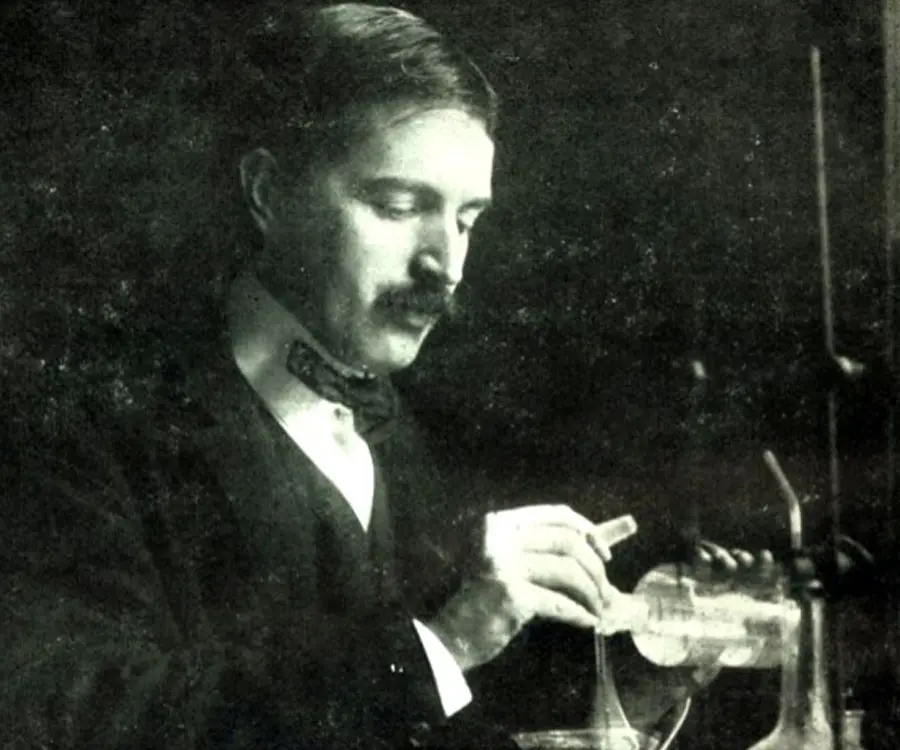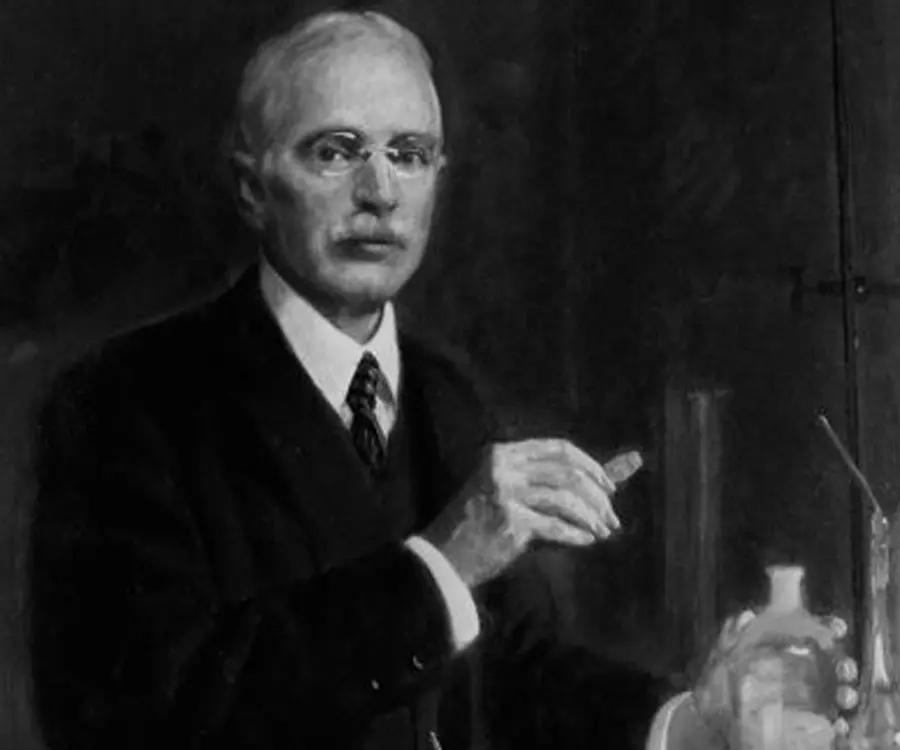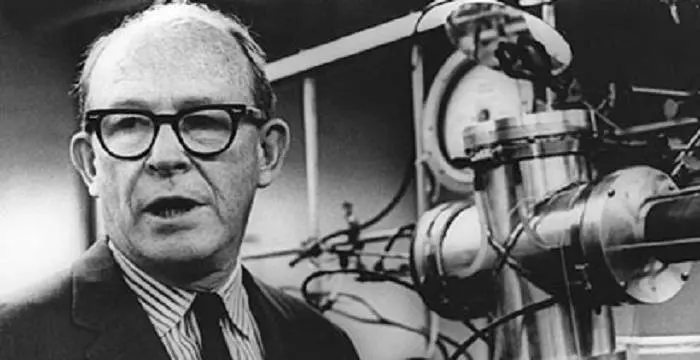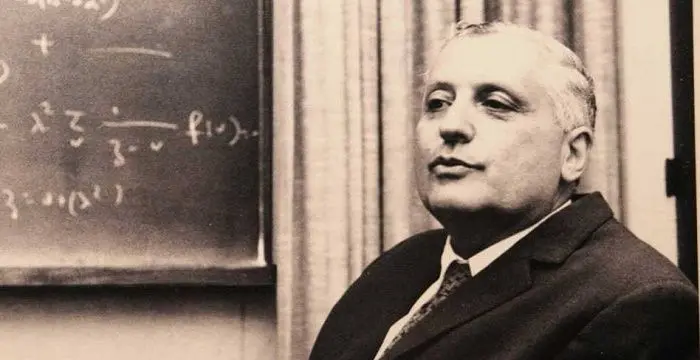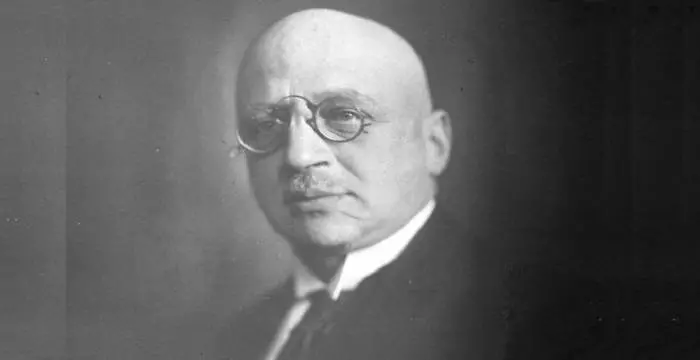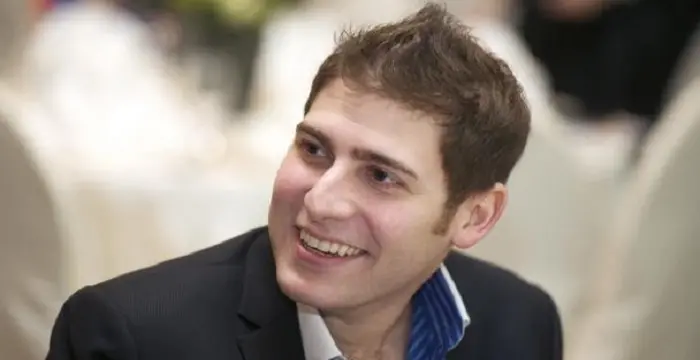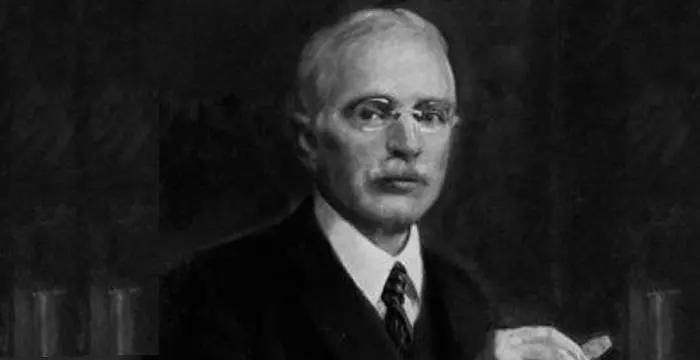
Theodore William Richards - Harvard University, Timeline and Childhood
Theodore William Richards's Personal Details
Theodore William Richards was an American scientist who was awarded the 1914 Nobel Prize in Chemistry
| Information | Detail |
|---|---|
| Birthday | January 31, 1868 |
| Died on | April 2, 1928 |
| Nationality | American |
| Famous | Harvard University, Scientists, Chemists, Physical Chemists |
| Spouses | Miriam Stuart Thayer |
| Known as | Theodore W. Richards |
| Childrens | Grace, Greenough Thayer, William Theodore |
| Universities |
|
| Notable Alumnis |
|
| Birth Place | Germantown, Pennsylvania, U.S. |
| Gender | Male |
| Father | William Trost Richards |
| Mother | Anna Matlack |
| Sun Sign | Aquarius |
| Born in | Germantown, Pennsylvania, U.S. |
| Famous as | Chemist |
| Died at Age | 60 |
// Famous Chemists
Henry Cavendish
Henry Cavendish was a theoretical chemist and physicist, renowned for discovery of hydrogen and calculation of the mass of earth. To know more about his childhood, profile, timeline and career read on
Walter Kohn
Nobel Laureate Walter Kohn was an Austrian-born American theoretical chemist and physicist. Check out this biography to know about his childhood, life, achievements, works & timeline.
Jabir Ibn Hayyan
Jabir Ibn Hayyan was a medieval era polymath. Check out this biography to know about his life, works and achievements.
Theodore William Richards's photo
Who is Theodore William Richards?
Theodore William Richards was an American scientist who was awarded the 1914 Nobel Prize in Chemistry for his work on the atomic weights of chemical elements. Born to distinguished parents, it was natural that he too would find a place among greats. He would later go on to credit his parents for encouraging and helping him on the path to success. Science beckoned him at a very young age and he, in turn, pursued it till his last breath. Academically, he was an exceptional student who was awarded many fellowships and honors. For someone who had no formal education until the age of 14, he earned a doctorate by the time he was 20. On completion of his academics, he became a teacher and researcher at Harvard University, remaining there for the most part of his career. He received many honorary degrees and medals throughout his career that included a Harvard professorship endowed in his name. Though most of his work dealt with the atomic weights of elements, his most productive contributions were in the fields of thermochemistry and electrochemistry. Verification of the concept of isotopes, determination of the atomic weights of over 55 elements, the discovery of the Third law of thermodynamics, and many such works are evidence of his invaluable research.
// Famous Physical Chemists
Willard Libby
Willard Frank Libby was an American physical chemist who was awarded the ‘Nobel Prize’ in Chemistry in 1960. This biography profiles his childhood, life, career, research, achievements and timeline.
Ilya Prigogine
Ilya Prigogine was a Russian-born Belgian physical chemist who was awarded the Nobel Prize for Chemistry in 1977. This biography of Ilya Prigogine provides detailed information about his childhood, life, achievements, works & timeline.
Fritz Haber
Fritz Haber was a German chemist who won the 1918 Nobel Prize in Chemistry for the synthesis of ammonia from its elements. Check out this biography to know about his childhood, life, achievements, works & timeline.
Childhood & Early Life
Born on January 31, 1868, in Germantown, Pennsylvania, Theodore William Richards was the third son and fifth child of William Trost Richards and Anna Matlack. His parents were highly gifted; his father being a noted seascape painter and his mother, a Quaker poet and author.
At the age of 6 he met Josiah Parsons Cooke, Jr., the Chemistry professor at Harvard University, during a vacation on Rhode Island. Cooke piqued the young boy’s interest in science by showing him the rings of Saturn through a telescope.
He received his elementary and secondary schooling at home because his mother felt that public education was aimed at the slowest student in the class. He was taught reading, writing, arithmetic, geography, history, music, and drawing by his mother till he joined Haverford College at the age of 14 in 1883.
Two years later, in 1885, he graduated from Haverford College at the top of the class with a degree in Chemistry. After his graduation, he enrolled in the senior class at Harvard for the fall semester. Despite being the youngest student in the class, he graduated with the highest honors in 1886 and received his Bachelor of Arts degree.
At the age of 20, in 1888, he obtained his doctorate in Chemistry. The topic of his dissertation was the determination of the atomic weight of oxygen relative to hydrogen which earned him the Parker fellowship.
His fellowship enabled him to travel and he spent the following year in Germany, where he continued his post-doctoral work under Victor Meyer, P. Jannasch, G. Kruss, and W. Hempel.
Career
Richards’ work began with his dissertation in 1888 where he studied on the atomic weights of oxygen and hydrogen. He conducted independent research and published papers on the atomic weights of oxygen, copper and silver and studied the heat produced by the reaction of silver nitrate with solutions of metallic chlorides.
After his return from Germany, Richards became an Assistant in Chemistry (quantitative analysis) at Harvard. He was appointed an instructor in 1891 and became an assistant professor in 1894.
In 1885, his mentor Cooke passed away and he was sent to visit labs in Leipzig and Göttingen to improve his qualifications to teach physical chemistry. It was then that his interest in thermochemistry and electrochemistry began to take shape.
He was offered the chair of physical chemistry at the University of Göttingen. Unwilling to part with a talent such as Richards, Harvard promoted him to a full professor in 1901.
In 1902, he was part of a study that was investigating the behavior of galvanic cells at low temperatures which led to the discovery, by Walther Nernst, of the “Nernst heat theorem” and the “Third law of thermodynamics” in 1906.
He was made the chairman of the Chemistry Department at Harvard in 1903 and remained in the position until 1911.
During his work in thermodynamics, he became aware of a few shortcomings in the calorimetric methods that were being used. To overcome these problems, Richards, along with Lawrence J. Henderson, and George Shannon Forbes invented an adiabatic calorimeter in 1905.
He was appointed Erving Professor of Chemistry and Director of the Wolcott Gibbs Memorial Laboratory in 1912. He held both these prestigious positions until his death in 1928.
By 1912, the atomic weights of over 25 elements, including those used to determine other atomic weights, were determined by him. Additionally, under his guidance, his students Gregory Baxter and Otto Hönigschmid determined atomic weights of many more elements.
In 1914, Richards and Max E. Lembert published a study which confirmed that lead from radioactive minerals has a different atomic weight from its non-radioactive forms. It was the only conclusive evidence for isotopes until the development of the mass spectrograph. Thus, he was one of the first chemists to show that an element could have different atomic weights.
In recognition of his exact determinations of the atomic weights of a large number of chemical elements, the Royal Swedish Academy of Sciences awarded him the Nobel Prize in Chemistry in 1914.
Apart from atomic weights, Richards also studied atomic and molecular volume formulating a hypothesis of compressible atoms, heats of solution and neutralization, and the electrochemistry of amalgams. He also introduced highly useful devices such as the quartz apparatus, the bottling device, and the nephelometer.
Richards was active in both teaching and research at Harvard till the end of his life. Many honors and tributes continued to come his way for his exceptional work and dedication to the sciences.
Major Works
During his life, he authored nearly 300 papers on atomic weights. He also published 2 books - the non-fiction ‘Determinations of Atomic Weights’ in 1910 and a biography, ‘The Scientific Work of Morris Loeb’ in 1913.
His best-known studies dealt with the atomic weights of elements, which constituted about half of his scientific research. He is credited with determining the atomic weight of over 25 elements, with the highest accuracy. His research also led to the invention of the adiabatic calorimeter and the nephelometer.
Awards & Achievements
He received the Davy Medal of the Royal Society (1910), the Faraday Medal of the Chemical Society (1911), the Willard Gibbs Medal of the American Chemical Society (1912), and the Franklin Medal of the Franklin Institute (1916).
Much of his research was dedicated to the subject of atomic weights, which began during his years at Haverford, for which he was awarded the Nobel Prize in Chemistry in 1914. The fact that an element can have different atomic weights was first established by him.
Personal Life & Legacy
He married Miriam Stuart Thayer, daughter of a Harvard Professor, Joseph Henry Thayer, on May 28, 1896. The couple lived in a house near the Harvard College yard built with the financial assistance of Richards’ father.
He became a father for the first time on February 1, 1889, with the birth of his daughter, Grace. He also fathered two sons, William Theodore and Greenough Thayer, both of whom became professors. William taught Chemistry at Princeton University whereas Greenough was an architect who taught design at Virginia Polytechnic Institute.
Richards apparently suffered from chronic respiratory problems and was also plagued by depression. He died on April 2, 1928, in Cambridge, Massachusetts at the age of 60.
Trivia
Richards was the first American to be awarded the Nobel Prize in Chemistry and the second among American scientists, the first being Albert A. Michelson in 1907.
His younger sister, Anna Mary Richards Brewster was a successful impressionist painter, sculptor, and illustrator.
// Famous Harvard University
Bertil Gotthard Ohlin
Bertil Gotthard Ohlin was a famous Swedish economist. This biography profiles his childhood, family life & achievements.
Xi Mingze
Xi Mingze is the daughter of Chinese Leader Xi Jinping, Check out this biography to know about her birthday, childhood, family life, achievements and fun facts about her.
Susan Sontag
Susan Sontag is an American critical essayist, cultural analyst, novelist, political activist, filmmaker and playwright of international repute. Read on to find out more about her childhood, career, profile and timeline.
Theodore William Richards's awards
| Year | Name | Award |
|---|---|---|
Other | ||
| 0 | Davy Medal (1910) | |
| 0 | Willard Gibbs Award (1912) | |
| 0 | Nobel Prize for Chemistry (1914) | |
| 0 | Franklin Medal (1916) | |
Theodore William Richards biography timelines
- // 31st Jan 1868Born on January 31, 1868, in Germantown, Pennsylvania, Theodore William Richards was the third son and fifth child of William Trost Richards and Anna Matlack. His parents were highly gifted; his father being a noted seascape painter and his mother, a Quaker poet and author.
- // 1883He received his elementary and secondary schooling at home because his mother felt that public education was aimed at the slowest student in the class. He was taught reading, writing, arithmetic, geography, history, music, and drawing by his mother till he joined Haverford College at the age of 14 in 1883.
- // 1885 To 1886Two years later, in 1885, he graduated from Haverford College at the top of the class with a degree in Chemistry. After his graduation, he enrolled in the senior class at Harvard for the fall semester. Despite being the youngest student in the class, he graduated with the highest honors in 1886 and received his Bachelor of Arts degree.
- // 1885In 1885, his mentor Cooke passed away and he was sent to visit labs in Leipzig and Göttingen to improve his qualifications to teach physical chemistry. It was then that his interest in thermochemistry and electrochemistry began to take shape.
- // 1888At the age of 20, in 1888, he obtained his doctorate in Chemistry. The topic of his dissertation was the determination of the atomic weight of oxygen relative to hydrogen which earned him the Parker fellowship.
- // 1888Richards’ work began with his dissertation in 1888 where he studied on the atomic weights of oxygen and hydrogen. He conducted independent research and published papers on the atomic weights of oxygen, copper and silver and studied the heat produced by the reaction of silver nitrate with solutions of metallic chlorides.
- // 1891 To 1894After his return from Germany, Richards became an Assistant in Chemistry (quantitative analysis) at Harvard. He was appointed an instructor in 1891 and became an assistant professor in 1894.
- // 28th May 1896He married Miriam Stuart Thayer, daughter of a Harvard Professor, Joseph Henry Thayer, on May 28, 1896. The couple lived in a house near the Harvard College yard built with the financial assistance of Richards’ father.
- // 1901He was offered the chair of physical chemistry at the University of Göttingen. Unwilling to part with a talent such as Richards, Harvard promoted him to a full professor in 1901.
- // 1902 To 1906In 1902, he was part of a study that was investigating the behavior of galvanic cells at low temperatures which led to the discovery, by Walther Nernst, of the “Nernst heat theorem” and the “Third law of thermodynamics” in 1906.
- // 1903 To 1911He was made the chairman of the Chemistry Department at Harvard in 1903 and remained in the position until 1911.
- // 1905During his work in thermodynamics, he became aware of a few shortcomings in the calorimetric methods that were being used. To overcome these problems, Richards, along with Lawrence J. Henderson, and George Shannon Forbes invented an adiabatic calorimeter in 1905.
- // 1907Richards was the first American to be awarded the Nobel Prize in Chemistry and the second among American scientists, the first being Albert A. Michelson in 1907.
- // 1910 To 1913During his life, he authored nearly 300 papers on atomic weights. He also published 2 books - the non-fiction ‘Determinations of Atomic Weights’ in 1910 and a biography, ‘The Scientific Work of Morris Loeb’ in 1913.
- // 1912 To 1928He was appointed Erving Professor of Chemistry and Director of the Wolcott Gibbs Memorial Laboratory in 1912. He held both these prestigious positions until his death in 1928.
- // 1912By 1912, the atomic weights of over 25 elements, including those used to determine other atomic weights, were determined by him. Additionally, under his guidance, his students Gregory Baxter and Otto Hönigschmid determined atomic weights of many more elements.
- // 1914In 1914, Richards and Max E. Lembert published a study which confirmed that lead from radioactive minerals has a different atomic weight from its non-radioactive forms. It was the only conclusive evidence for isotopes until the development of the mass spectrograph. Thus, he was one of the first chemists to show that an element could have different atomic weights.
- // 1914In recognition of his exact determinations of the atomic weights of a large number of chemical elements, the Royal Swedish Academy of Sciences awarded him the Nobel Prize in Chemistry in 1914.
- // 1914Much of his research was dedicated to the subject of atomic weights, which began during his years at Haverford, for which he was awarded the Nobel Prize in Chemistry in 1914. The fact that an element can have different atomic weights was first established by him.
- // 2nd Apr 1928Richards apparently suffered from chronic respiratory problems and was also plagued by depression. He died on April 2, 1928, in Cambridge, Massachusetts at the age of 60.
- // 1st Feb 1989He became a father for the first time on February 1, 1889, with the birth of his daughter, Grace. He also fathered two sons, William Theodore and Greenough Thayer, both of whom became professors. William taught Chemistry at Princeton University whereas Greenough was an architect who taught design at Virginia Polytechnic Institute.
// Famous Scientists
Juliane Koepcke
Juliane Koepcke is a German-Peruvian biologist, who was the lone survivor among the 92 passengers and crew of the ill-fated LANSA Flight 508 that crashed in the Peruvian rainforest on 24 December 1971. Know more about her life in this biography.
Henry Cavendish
Henry Cavendish was a theoretical chemist and physicist, renowned for discovery of hydrogen and calculation of the mass of earth. To know more about his childhood, profile, timeline and career read on
Konstantin Tsiolkovsky
Konstantin Tsiolkovsky was a Russian rocket scientist and a pioneer of astronautics. This biography provides detailed information about his childhood, family, personal life, career, achievements, etc.
Gabe Newell
Gabe Newell is an American computer programmer and businessman, best known as the co-founder of ‘Valve Corporation.’ This biography provides detailed information about his childhood, family, personal life, career, etc.
Grigori Perelman
Grigori Perelman is a Russian mathematician who is best known for his contributions to Riemannian geometry and geometric topology. Check out this biography to know about his childhood, family life, achievements and fun facts about him.
Eduardo Saverin
Eduardo Luiz Saverin is a Brazilian internet entrepreneur and investor. This biography profiles his childhood, life, career, achievements, and timeline
Theodore William Richards's FAQ
What is Theodore William Richards birthday?
Theodore William Richards was born at 1868-01-31
When was Theodore William Richards died?
Theodore William Richards was died at 1928-04-02
Where was Theodore William Richards died?
Theodore William Richards was died in Cambridge
Which age was Theodore William Richards died?
Theodore William Richards was died at age 60
Where is Theodore William Richards's birth place?
Theodore William Richards was born in Germantown, Pennsylvania, U.S.
What is Theodore William Richards nationalities?
Theodore William Richards's nationalities is American
Who is Theodore William Richards spouses?
Theodore William Richards's spouses is Miriam Stuart Thayer
Who is Theodore William Richards childrens?
Theodore William Richards's childrens is Grace, Greenough Thayer, William Theodore
What was Theodore William Richards universities?
Theodore William Richards studied at Harvard University, Harvard University, Haverford College
What was Theodore William Richards notable alumnis?
Theodore William Richards's notable alumnis is Harvard University
Who is Theodore William Richards's father?
Theodore William Richards's father is William Trost Richards
Who is Theodore William Richards's mother?
Theodore William Richards's mother is Anna Matlack
What is Theodore William Richards's sun sign?
Theodore William Richards is Aquarius
How famous is Theodore William Richards?
Theodore William Richards is famouse as Chemist



